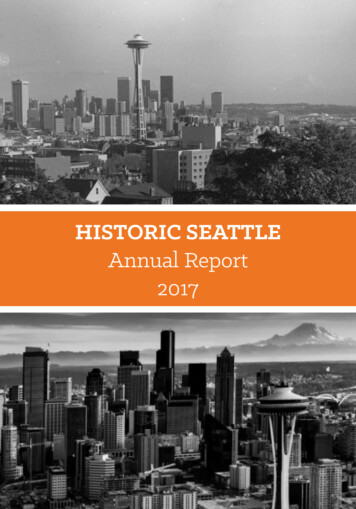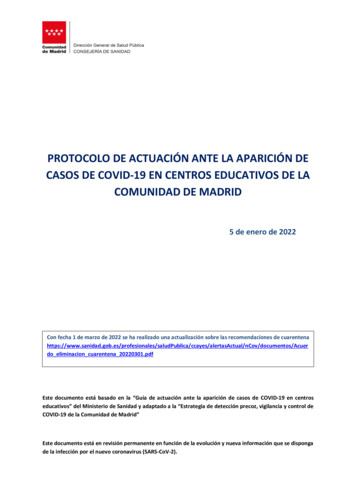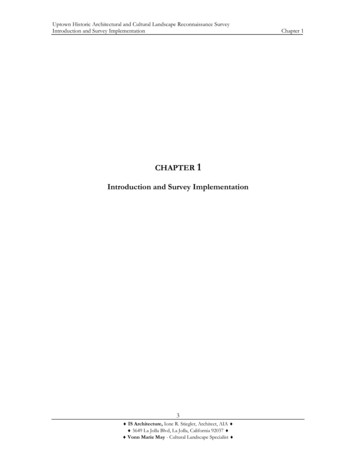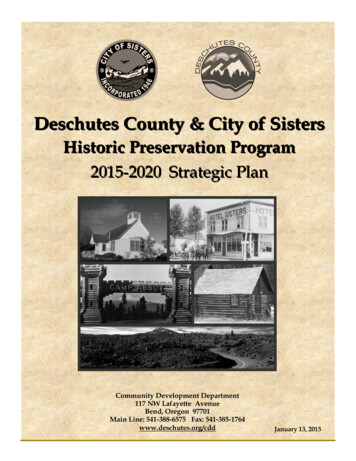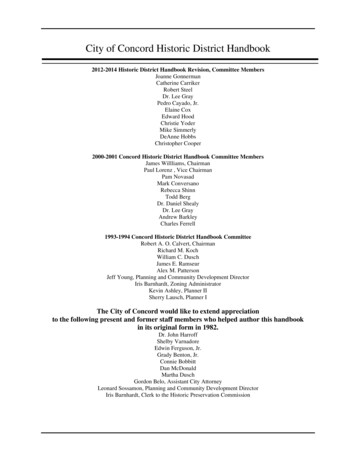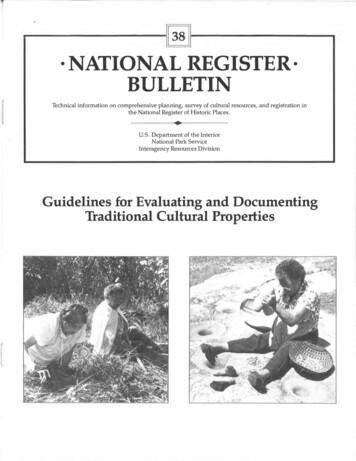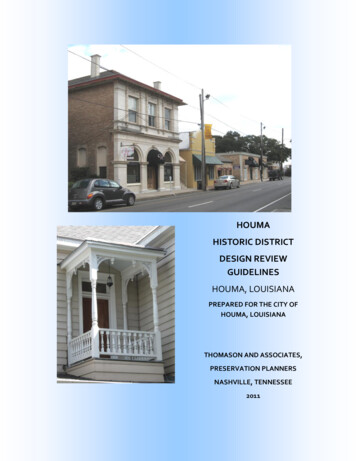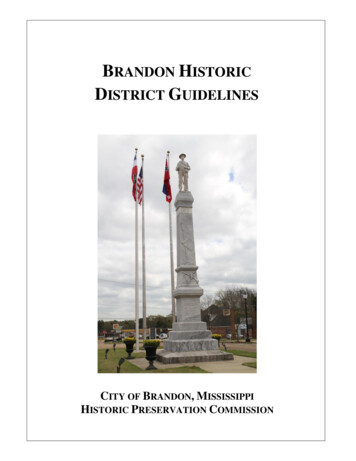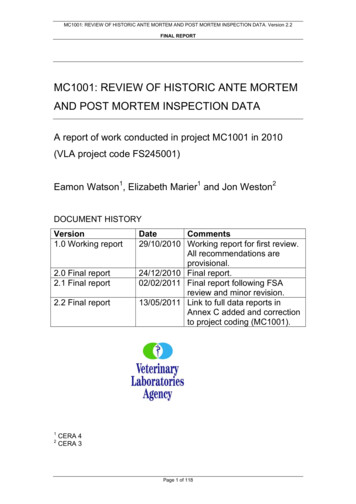
Transcription
MC1001: REVIEW OF HISTORIC ANTE MORTEM AND POST MORTEM INSPECTION DATA. Version 2.2FINAL REPORTMC1001: REVIEW OF HISTORIC ANTE MORTEMAND POST MORTEM INSPECTION DATAA report of work conducted in project MC1001 in 2010(VLA project code FS245001)Eamon Watson1, Elizabeth Marier1 and Jon Weston2DOCUMENT HISTORYVersion1.0 Working report2.0 Final report2.1 Final report2.2 Final report12DateComments29/10/2010 Working report for first review.All recommendations areprovisional.24/12/2010 Final report.02/02/2011 Final report following FSAreview and minor revision.13/05/2011 Link to full data reports inAnnex C added and correctionto project coding (MC1001).CERA 4CERA 3Page 1 of 118
MC1001: REVIEW OF HISTORIC ANTE MORTEM AND POST MORTEM INSPECTION DATA. Version 2.2FINAL REPORTTABLE OF CONTENTSExecutive summary3Section 1:BackgroundOutline of the studyAbattoirs in Great BritainFSA regionsList of conditionsData management445666Section 2:Review of data qualityMethodologyAbattoir visitsUnderstanding data managementOverview of sample datasetObservations on data quality88891012Section 3:Review of list of conditions26Section 4:Identifying gapsDenominators and geo-locationCase studiesOpportunities for using the data31313235Section 5:Discussion and Recommendations41Annex AAcknowledgements46Annex BSummary of data extract47Annex C1Summary of data reports48Annex DProposed list of ante mortem inspection conditions60Annex EProposed list of post mortem inspection conditions80Annex FA short history of meat inspection in Great Britain61Annexes1As at 13/05/2011, the full set of data reports presented in Annex C are available from this link:http://vla.defra.gov.uk/reports/rep rev ampm data.htm. Please note that this link may be subject to change in thefuture. If this occurs then a revised report with an updated link will be provided.Page 2 of 118
MC1001: REVIEW OF HISTORIC ANTE MORTEM AND POST MORTEM INSPECTION DATA. Version 2.2FINAL REPORTEXECUTIVE SUMMARYThis report reviews the data that are collected during ante mortem and post morteminspection at abattoirs in Great Britain. During the course of this work we visitedabattoirs to understand how the data are collected and visited FSA York offices tounderstand how the information is managed. We were provided with a data extract tohelp us to further explore the data.Integral to this, we reviewed the list of conditions that were being used at antemortem and post mortem inspection. This was done with the assistance ofstakeholders.From these components we were able to draw together observations on data quality,identify where there were gaps in the data and explore opportunities for use of thedata.At the outset, we would like to recognise the efforts that go into the collection of thedata. The requirement for data recording at the abattoir is well embedded in theinspection procedure. It is also important to note that at the time of this review datasystems were in a transitional state, with the recent introduction of a new NextGeneration AM/PM system to manage data from pigs and poultry.Currently, the accuracy of data is compromised through variation in the recording ofconditions at the animal level and the expression of a clear denominator. There isalso the need for an administrative layer to remove complexity and check forconsistency before data can be used more widely. It is recognised that many of theissues we identify in this report are in the process of being addressed as the NextGeneration AM/PM system extends to cover cattle and sheep.We have made recommendations that we feel are practical and constructive with theobjective of gaining maximum value from the data. A full discussion withrecommendations is given in Section 5, but in short, we make the followingrecommendations: FSA should actively promote the availability of ante mortem and post morteminspection data.The list of conditions must be reviewed regularly to ensure it is workable. Thematrix of conditions and body parts, where appropriate, must be as conciseas possible.It is important to define the working process to add clarity for the recording ofdata for each species.The data need to be described in a way that points out any limitations.CCIR data should be promoted and developed across all the livestocksectors.There needs to be a clear program for the longer term development of datasystems management.Finally, during the course of this work it has become apparent that there are manystakeholders with an active interest in this data. There are considerable opportunitiesfor FSA to engage with stakeholders and develop the contribution this data can maketo protecting animal health – both at the farm level and to complement nationaldisease surveillance.Page 3 of 118
MC1001: REVIEW OF HISTORIC ANTE MORTEM AND POST MORTEM INSPECTION DATA. Version 2.2FINAL REPORTSECTION 1: BACKGROUNDOutline of the study1.1.This report is the deliverable from the work undertaken in project MC1001.The scope of the work was to; review the recording of conditions at ante andpost mortem inspection, to assess the fitness for purpose of these data, andto provide recommendations as appropriate. A schematic of the project isshown in Figure 1.1.Figure 1.1 Schematic outline of the study1.1 Understand FSA(formerly MHS) datacollectionprocedures, formsand documentation.1.2 Define, byspecies, diseaseconditions to record(i.e. define currentdata needs).Milestone 1Deliverable 12.1 Appraisemethods for datacollection.2.2 Extract andcollate historic antemortem and postmortem data.3.1 Evaluate dataquality issues andvariation in dataquality.Milestone 23.2 Identify datagaps.4.1 Final report.Milestone 3Deliverable 21.2.The report does not include a comprehensive literature review of the subject,but where appropriate, references to previously published work have beenused to illustrate key points.1.3.Work began in March 2010 and was completed in December 2010. Progresssummary reports were provided during the course of the work. The key timepoints are summarised in Table 1.1.Page 4 of 118
MC1001: REVIEW OF HISTORIC ANTE MORTEM AND POST MORTEM INSPECTION DATA. Version 2.2FINAL REPORTTable 1.1 Summary of study progressDateMarch 2010May 2010July 2010October 2010November 2010December 2010ActionsContract documents completed.Request FSA assistance for abattoir visits and data extract.Copies of forms provided and list of conditions extracted.Expert review of conditions in progress.Liaise with FSA to provide historic data extract.Visits to seven abattoirs completed.Expert review of conditions in progress.Attend BPEX health information workshop re: pig conditions.Attend FSA FCI/CCIR cattle and sheep stakeholder meeting.Data extract received from FSA.Review of data quality in progress.Visit to FSA York for revised dataset.Working report in preparation, to include: review of conditions, revisedconditions list, appraisal of historic data, listing of data quality issues andprovisional recommendations.Working report submitted 29/10/10.Working report presentation to FSA for discussion and review.Visit to FSA York for review of working report.Final report completed following FSA feedback on working report and CVI,Wageningen consultancy.Abattoirs in Great Britain1.4.There are many abattoirs in operation in Great Britain (GB). Table 1.2 gives abreakdown of abattoirs in GB. It is important to note that many abattoirs willkill more than one species and therefore may be counted more than once.Table 1.2 Number of abattoirs in GB (July 2010)2UngulatesPoultrySmall GameCattleGoatsSheepPigsOther farmedmammals; deer, wildboar, bisonPoultryWild birdsWild lagomorphsWild 413286545360480Large GameTOTAL abattoirsbaTwo are “on farm slaughter” facilitiesbMany abattoirs will handle than one species.1.5.There is variation in how abattoirs collate data, but generally daily totals arecollated locally before being sent weekly to FSA York. Traditionally this hastaken the format of paper records being posted and manually entered ontothe database at FSA York. With the phased introduction of the new NextGeneration AM/PM system, data recording and transfer of totals will be donedaily and electronically in eligible plants.2Data for this table has been derived plantsprems/meatpremlicencePage 5 of 118
MC1001: REVIEW OF HISTORIC ANTE MORTEM AND POST MORTEM INSPECTION DATA. Version 2.2FINAL REPORTFSA regions1.6.There are 12 defined FSA business areas and 37 sub-business areascovering GB. These business areas or sub-business areas are not directlycomparable with Nomenclature of Units for Territorial Statistics (NUTS).However postal code reference for each abattoir can be used to allocateNUTS region(s).1.7.One point to note is that the abattoir postal code is the final destination of theanimal and does not refer to the last premise the animal was kept.List of conditions1.8.The list of conditions has evolved from the early days of meat inspection,through the introduction of a computerised recording system in 2006, to thecurrent listings used today. The most recent and significant development inthe listing of conditions follows the implementation of Food Chain Information(FCI) and with it the Collection and Communication of Inspection Results(CCIR). FCI refers to information that might affect the process in the abattoir(for example, medicine withdrawal periods) and the producer must make thisinformation available to the Food Business Operator (FBO). CCIR refers tothe data on conditions recorded during abattoir inspection and must bereported to the producer. This is in response to EU regulations; 853/2004(FCI) and 854/2004 (CCIR), which came into force on 1 January 2006. Ashort history of meat inspection in GB is summarised in Annex F.1.9.In GB, implementation is a phased process, during which time the FSA,formerly Meat Hygiene Service (MHS) has worked with the industry and otherstakeholders to develop new condition headings under which the inspectionresults will be recorded. Critically this has two aims3; “ gathering information and reporting it in a form which will be ofmaximum benefit for all – slaughterhouse operators, pig producers andtheir vets”, and “ better methods of recording inspection results will permit improvedanalysis for disease surveillance purposes.”Data management1.10.Historically data collection and reporting has been paper based, with recordsbeing transferred into a central database. This is still largely the case for nonpig and poultry species. For the purposes of this report, the paper basedworking process will be referred to as the ‘AM/PM system’. In practice,CCIR for the FBO and producer has been available for all species since 2006using these paper based reports.1.11.However, to make the process of handling FCI and CCIR more efficientthere has been a requirement for an additional Information Technology(IT) system. The response to this has been the introduction of a new NextGeneration AM/PM system. We understand that the Next Generation gletterscot071113.pdfPage 6 of 118
MC1001: REVIEW OF HISTORIC ANTE MORTEM AND POST MORTEM INSPECTION DATA. Version 2.2FINAL REPORTsystem was built to a detailed specification provided by FSA using acommercial IT application. Further details of the application are availabledirectly from Rosie Ripley, IT department, FSA (personal communication).1.12.Currently the provision of FCI and CCIR electronically is in place for pigs andpoultry, with planned introduction for cattle and sheep during 20011-12 (Table1.3). For the purposes of this report, the ‘Next Generation AM/PM system’will be used to refer to the electronic working process.Table 1.3 The phased introduction of the Next Generation AM/PM system forFCI and CCIRSpeciesCattleCalvesSheepGoatsPigsDate ofimplementationNot implementedNot implementedNot implementedNot implementedAugust 2010PoultryJuly 2010Small GameNot defined.Large Game (includesfarmed deer)Not defined.1.13.NotesPlanned 2011Planned 2011Planned 2012Planned 2012From 25/10/2010 all plants in GB are using the NextGeneration AM/PM system.From 25/07/2010 all plants in GB are using the NextGeneration AM/PM system.The introduction of the Next Generation AM/PM systemis dependent on approved funding.The introduction of the Next Generation AM/PM systemis dependent on approved funding.The AM/PM system works on paper based forms. There are multiple formsin use to record conditions. These are summarised in Table 1.4.Table 1.4 Summary of forms for recording dataSpeciesCattleCalvesSheepGoatsPigs (& wild boar)Avian (broilers, hens, turkeys,geese, ducks, guinea fowl andquail)Farmed deerLarge wild game (deer)Small wild game(pheasant/grouse/partridge,pigeon, duck/snipe/other,rabbit/hare)Ante mortem:dailyAMI 2/5AMI 2/5AMI 2/5AMI 2/5CIR 12/2Ante mortem:weeklyAMI 2/6AMI 2/6AMI 2/6AMI 2/6Post mortem:weeklyPMI 4/9PMI 4/9PMI 4/9PMI 4/9AMI 2/4Post mortem:dailyPMI 4/1PMI 4/1PMI 4/6PMI 4/3PMI 4/5CIR 12/2CIR 12/1AMI 2/4AMI 2/5-AMI 2/6-PMI 4/2-PMI 4/9PMI 4/12PMI 4/12Page 7 of 118PMI 4/10
MC1001: REVIEW OF HISTORIC ANTE MORTEM AND POST MORTEM INSPECTION DATA. Version 2.2FINAL REPORTSECTION 2: REVIEW OF DATA QUALITYMethodology2.1The review of data quality was based on: Semi-structured interviews during abattoir visits,Understanding data management at FSA York,Examination of a sample dataset, andKnowledge from reviewer participation at workshops.Abattoir visits2.2Seven abattoirs were visited and these are summarised in Table 2.1.During abattoir visits the reviewers were able to hold discussions withSenior/Meat Hygiene Inspectors (S/MHIs), Official Veterinarians (OVs) andplant staff. Discussions were informal, using a semi-structured approach witha series of questions. Questions were related to: Appraisal of local procedures (throughput, data collection and recording),Data quality issues (recording accuracy, variation within and betweenplants and audit/verification procedures),Rationale and motivation to record (current or amended list of conditions),andSuggestions for changes in procedures to enhance accurate andcomplete data recording.Table 2.1 Summary of abattoir visits#PlantCategoryDate visitedThroughput(estimated)1ABP Guildford(Surrey)Cattle only18/610MediumthroughputRed meatEW, EM, JWCattle 150/d(including 6calves/week)Low throughputEW, EM, JWCattle only, incl.dairy cattle (OTM)and TB ex)BeesonsCrewe(Cheshire)Moy colnshire)2 Sisters kshire)MediumthroughputWhite meat(poultry)21/6/10Numberof MHIson line5Cattle 1020/weekPigs 70/wkSheep 350/wk1Cattle 200/week5Broilers580,000/week2Pigs 12,500/week5Broilers c.1.7m/week6Varies withseason and typeof animals.1EW25/6/10EWHigh throughputPig only (finishingpigs 6 monthsonly)30/06/10EWHigh throughputPoultry01/07/10High throughputEWGame06/07/10Cutting plantEMPage 8 of 118Data recordingWhiteboard to localpaper form to FSAform.Paper note (post-it orpaper sheet) to FSAforms. To NextGeneration AM/PMsystem for pigs.Whiteboard to localpaper form to FSAform.Local procedureswith clickers, whiteboards and paperforms.Laminated forms toNext GenerationAM/PM system.Local procedureswith clickers, paperforms to NextGeneration AM/PMsystem.Day book
MC1001: REVIEW OF HISTORIC ANTE MORTEM AND POST MORTEM INSPECTION DATA. Version 2.2FINAL REPORTUnderstanding data management2.3Ante mortem and post mortem inspection data are managed by FSA inYork. Staff have expertise in data systems and in the daily use of the datawarehouse.2.4In simple terms, data are in a transitional stage from the old to NextGeneration AM/PM system. This means that current and historic data forpigs and poultry are kept across the old and Next Generation AM/PMsystems, and that for other species this transitional stage will follow over thenext few years. This is relatively straightforward in terms of recordingconditions identified at ante mortem and post mortem inspection; allowing forcounts of conditions to be retrieved. Figure 2.1 provides a summary of thedatabase chronology.Figure 2.1 Summary of FSA data collection systems from 2006.OM IS intro duced in A pril1994. This system capturesdata supplied o n weeklyplant returns. Includes allspecies except pigs andpo ultry.2006Next Generatio n A M /P Msystem fo r po ultry ro lledo ut to all plants.Next Generatio n A M /P Msystem pilo t fo r cattleplanned.Next Generatio n A M /P MNext Generatio n A M /P Msystem pilo t fo r po ultrysystem pilo t fo r sheepstarts. Data entered at theplanned.plant.SIR replaces OM IS fo r allspecies excluding pigs andpo ultry. Data captureco ntinues based o n weeklyreturns.2008B P EX intro duced. Uses anapplicatio n develo ped inho use. Includes pig plantso nly. Data capture basedo n manual returns.2.520102012Next Generatio n A M /P Msystem fo r pigs ro lled o utto all plants, replacingB P EX.Next Generatio n A M /P Msystem pilo t fo r pigs starts,initially at fo ur plants.To ensure correct information is relayed, we sought the input from FSA Yorkfor the following description for the implementation of the NextGeneration AM/PM system. “Moving forward the FSA have purchased software licences to roll out thenew AM and PM data collection and reporting application to all abattoirsacross GB. The strategy is to systematically decommission the AM/PMsystem species by species - the Cattle project has already been started.During the roll out of new species specific bespoke batch screens will bespecified by the project team this can be for batches or for individualanimals depending on what is appropriate. These screens are thencreated taking into account lessons learned from the pig and poultryprojects and where possible improvements will be made across allspecies e.g. improved front end validation for instance linking producersto species to validate the producer selection. Inspection screens will thenbe linked to the batch screens which are fully customisable ensuring thatthe FSA have full control over conditions and body parts and changes canbe made to these internally. During the decommissioning process thePage 9 of 118
MC1001: REVIEW OF HISTORIC ANTE MORTEM AND POST MORTEM INSPECTION DATA. Version 2.2FINAL REPORTarchive data e.g. from AM/PM and OMIS will be extracted, transformedand loaded into a data warehouse ensuring consistent reporting acrosssystems.” (Howard Betts, FSA York, personal communication).2.6Again, in short, there are three relevant datasets in use; the NextGeneration AM/PM system, the AM/PM system and throughput. Thesethree datasets are the cornerstone of any reports making use of the antemortem and post mortem inspection data. Table 2.2 provides a summary ofdata management systems. One point of note is that the recording ofthroughput data (i.e. the numbers of animals presented at each abattoir) isnow recorded in the Next Generation AM/PM system.Table 2.2 Summary of the AM/PM system, Next Generation AM/PM system andthroughput peciesCattle, smallruminant andgamespeciesPigs andpoultryAllDatabase(s)‘OMIS’ (prior to May 2008)‘AM/PM’ (from May 2008).Comment100’s of paper forms per week.The AM/PM system storesdata in the ‘SIR’ – SingleInformation Repository.‘Next Generation AM/PM’Paper forms sent by fax, emailor post from the plants andreceived by FSA York formanual input into database.Data are entered electronicallydirectly at the abattoir.‘Throughput’Includes data on the number ofanimals presented for slaughter.Throughput (based on livestockunits) is independent, but linkedwith the AM/PM system.2.7Subject to available funding, it is planned that data from all species, includinglesser species such as game, will be managed through the Next GenerationAM/PM system. However it is important to note that there may well becontinued reliance on both the old and Next Generation AM/PM systemsfor some time beyond 2012.2.8Whilst a full review of IT systems is beyond the scope of this report, we areassured that a long term strategic approach is in place to establish theNext Generation AM/PM system for the recording of inspection dataacross all species.Overview of sample dataset2.9The data extract provided to us has proved to be complex. This is due tothe nature of the datasets, which when merged; add a layer of complexity andinconsistency. Primarily, this is due to the evolution of each system to holddifferent information.2.10It was anticipated that it would be relatively straightforward to request andreceive a data extract for conditions and throughput, against each species, tocover the last five years. In practice, the data extract received wascompromised by reportedly insufficient time resource to better formulate theextract to meet our requirement. That is, the data would have gone throughPage 10 of 118
MC1001: REVIEW OF HISTORIC ANTE MORTEM AND POST MORTEM INSPECTION DATA. Version 2.2FINAL REPORTan administrative filter to remove complexity and check for consistency.The need to do this supports the observation that the extraction of data frommultiple systems is complex.2.11It is recognised that looking forwards, with the adoption of the NextGeneration AM/PM system, the FSA expect to have an improved datawarehouse that is more suitable to provide assured data extracts.2.12Annex B summarises the different databases and the data extract used forthis report. We were able to construct new universes from the data extractwhich enabled us to develop our own data queries and outputs.2.13A list of our reports from the data extract, with descriptions and exampleoutputs, are shown in Annex C.2.14The frequency of observations recorded varies by species and betweenante mortem and post mortem inspection. It is not possible to simplydefine the proportion of animals that are identified as having a conditionrecorded. This is because multiple conditions or the multiple occurrenceof a condition may be recorded to a single animal – with variationdepending on species. For example, if a pig has one abscess on a hind legand one on its shoulder, abscess will be recorded twice. Similarly if two pigseach have one abscess, they will also be recorded twice. For a producerstakeholder knowing multiple counts of a condition may be important, and forthe FBO may provide justification for total or partial carcase rejection.However, for surveillance purposes, where incidence of a condition is a moreuseful measure, recording the multiple occurrence of a condition on a singleanimal can present problems for data analysis.2.15The frequency of recording ante mortem conditions is lower than postmortem conditions. This was consistent across the main species and wasexpected, given the nature of post mortem inspection compared to antemortem.2.16There are no ante mortem conditions for wild game species. This isbecause game plants receive carcases only. There are fewer post mortemconditions as generally the hunters will examine and remove the viscera. Onlyin the rare instance where there is an obvious abnormality will the viscera bepresented with the carcase for inspection.2.17Table 2.3 presents the number of conditions recorded at ante mortem andpost mortem inspection. Around a third of the conditions accounted for95% of all observations. This was expected; common conditions arecommon. It does however highlight the conflict between a succinct list ofconditions to record common conditions only, and a comprehensive listrecording more conditions, which is potentially of greater value acrossmultiple stakeholders. In practice, this is where the need to record forstakeholder requirement has to be matched to working systems andreasonable expectation of what is achievable across abattoirs.Page 11 of 118
MC1001: REVIEW OF HISTORIC ANTE MORTEM AND POST MORTEM INSPECTION DATA. Version 2.2FINAL REPORTTable 2.3 Summary of throughput, count of observations recorded and numberof conditions contributing to 80, 90 and 95% of all observations. Data for allspecies, except pigs covers a two year period (01/07/08-30/06/10). Data for pigscovers a one year period (01/09/09-30/08/10).SpeciesNo. of conditions–incl.‘other’–listed on forms(recorded on dataset)AntePost mortemmortemCalves2728Cattle27 (37)41 (46)Sheep27 (35)29 (37)Goats27 (33)29Pigs35 (31)47 (40)Total conditions incidents [NB Not animal level - more than onecondition may be recorded for the same animal]Ante mortemCount ofobs.1,698Of all observations,No. of conditionscontributing to:80%90%95%Post mortemOf all observations,No. of conditionscontributing to:Count of80% 90% 0101,714,8656912Broilers21 (21)13,294,35191215Ducks21 (21)347,46071013Geese21 (14)3076810Hens21 (21)1,114,7697911Turkeys21 (21)133,9097810Large wildgameSmall wildgame-27----NANANANA-28 (20)----223,001456Observations on data quality2.18We have tried to present our observations in an order that broadly follows thesteps from stakeholder requirement, through collection and management, tostakeholder reporting.2.19Data for GB are available in a central warehouse and availableelectronically. This is a significant achievement and as such places FSA inan enviable position of having full GB representation. Whilst this may seem tobe taken for granted, it is not the position in The Netherlands, where there isno central recording of data on a national scale (Swanenburg M, CentralVeterinary Institute, NL, personal communication).2.20The data are potentially very valuable to a range of stakeholders. Datamay be used to provide simple baseline information for endemic disease,welfare (on-farm or in transport), zoonoses and exotic/notifiable disease. Datamay equally be useful in demonstrating the absence of specific conditions.The data are of most use when set against a denominator. For example, 1%of 2.2 million sheep presented “lame”.2.21The notion of recording for disease surveillance purposes isestablished for poultry. “The farmer may use this information to improve thehealth status of his stock. Defra will use the data for disease surveillancetherefore the accuracy of the information is vital4.” It is a requirement of thelegislation to provide information to producers (CCIR), however not all4Manual for Official Controls, Chapter 2.1: FCI and CCIR Amendment 36, Section 3-1Page 12 of 118
MC1001: REVIEW OF HISTORIC ANTE MORTEM AND POST MORTEM INSPECTION DATA. Version 2.2FINAL REPORTproducers are interested in the results, for example producers were notinterested in the results from cull ewes5.2.22Meat Hygiene Inspectors (MHI) and Official Veterinarians (OV) werelargely unaware of the potential value of the data with regard to GBsurveillance and how it could potentially complement existing scanningsurveillance. There was a variable response as to how MHIs saw their role;from “to protect the food chain, not surveillance for disease” and “don’t knowwhy record – to whose advantage” to “interested to contribute to surveillance”and “identify where your bit fits into the bigger picture”.2.23MHIs and OVs receive little or no feedback on the trends of conditionsrecorded. This is unfortunate as potentially this is of great interest, either at alocal plant level or as part of a wider regional or national level. Some plantsreviewed local records but these were mainly for the FBO to assess plantworking practice and costs with regard to levels of carcase contamination.One Lead Veterinarian (LV) commented that “feedback would be a stimulusto record”. We identified three routes of feedback of data currently available; As an article in ‘Tech Files’. Tech Files is a monthly newsletter producedby FSA York staff. It contains news items of current interest and includesinformation on conditions as appropriate. Through ‘disease cards’. Disease cards are an in-house information noteon selected conditions across selected species, primarily poultry and pigs.As an example on the use of condition data the current (at July 2010)disease card for pododermatitis describes “the average level of rejectionfor pododermatitis in poultry GB 2007 0.05%”. This is limited informationand out of date. Through the ‘broiler condition report’ that is an output from the NextGeneration AM/PM system and presents a batch summary of conditionsfor broilers where selected conditions exceed a threshold.2.24Late in the course of this work we identified that there are scheduledformatted reports available from FSA York that describe frequency ofconditions, by species and plant (similar to report 5 in Annex C that wecreated from the data extract). It would be favourable to make these reportsavailable to MHIs and OVs. Ideally there would be the means to have asimple ‘query tool’ to facilitate local custom reports. We have not determinedfurther how this could be implemented or the feasibility of access by allabattoirs.2.25The recording of condition data is a statutory requirement and theprinciples are firmly embedded in day to day working. The process forrecording data varies between plants. This is understandable as it is aprocedure that has to integrate with the practicalities of the plant. To ensurethat the paperwork was kept clean, many opted to transcribe informationaway from the line. It was not practical to record data on the form directly onthe line. At each plant visited different local procedures were in place;however the end point was the same with records being collated.5Point 8.5 from minutes of Meeting on food chain information (FCI) and collection and communication of inspectionresults (CCIR) for cattle and sheep, 08/07/2010, FSA, Aviation House.Page 13 of 118
MC1001: REVIEW OF HISTORIC ANTE MORTEM AND POST MORTEM INSPECTION DATA. Version 2.2FINAL REPORT2.26It is a requirement that the FB
MC1001: REVIEW OF HISTORIC ANTE MORTEM AND POST MORTEM INSPECTION DATA. Version 2.2 FINAL REPORT Page 1 of 118 MC1001: REVIEW OF HISTORIC ANTE MORTEM AND POST MORTEM INSPECTION DATA A report of work conducted in project MC1001 in 2010 (VLA project code FS245001) Eamon Watson1, Elizabeth Marier1 and Jon Weston2 DOCUMENT HISTORY

